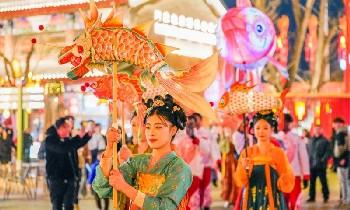
Why Chinese Spring Festival becomes a ‘global moment’
Global Times
As the Spring Festival of the Year of the Snake draws near, regardless of one’s location or the hustle and bustle of daily life, the chime of the Spring Festival always evokes a deep sense of nostalgia and longing for home inside Chinese people’s hearts. Today, the Spring Festival, the most important traditional festival in the hearts of the Chinese, is also being empowered by advancements in economy, culture, society, and technology, becoming a shining emblem that showcases Chinese modernization.
Once, the Spring Festival travel rush was a crowded journey on green-coated slow trains. Today, the country’s comprehensive multi-layered transportation network spans 6 million kilometers, with railway passenger trips expected to exceed 510 million during the Spring Festival travel season. New lines such as the Shanghai-Suzhou-Huzhou and Jining-Datong-Yuanping lines have commenced operations. Over 30,000 charging stations and nearly 50,000 charging spaces on highways serve the growing number of new energy vehicle owners. Sixteen domestically produced C919 large aircraft have joined the “warm journey home” for the Spring Festival. Cities like Shanghai, Tianjin, and Guangzhou are witnessing a new surge in cruise travel, with the “Spring Festival travel rush on the sea” expected to surpass 100,000 passenger trips. The increasingly convenient and comfortable journey home for the Chinese during the Spring Festival is a testament to the transformative changes in China’s transportation infrastructure.
The enhancement of happiness during the Spring Festival by Chinese modernization extends far beyond a single dimension. Smart lanterns, augmented reality light shows, and digital temple fairs infuse the festival with a sense of technological advancement that keeps pace with the times. Innovations like “rotational holidays” and “intelligent logistics” enable people to fully embrace the Spring Festival through high-quality development. From the Spring Festival Gala to Chinese New Year movies, and from games and live streams to micro-dramas, the cultural life during the Spring Festival is vibrant and diverse. Beijing Daxing International Airport provides special care bracelets for passengers such as the elderly and pregnant women, while Shenzhen North Station introduces the “Easy Travel” service, allowing passengers to bid farewell to the hassle of carrying heavy luggage. Centered on people’s livelihoods, Chinese modernization adds warmth to our Spring Festival celebrations.
The Spring Festival of the Year of the Yi Si (according to the Chinese lunar calendar) will be the first “World Intangible Cultural Heritage Edition” Spring Festival. The Chinese New Year is also a “World’s New Year,” not merely as an impression but as a vivid reality. During the upcoming global “Spring Festival Week,” if we stroll through Trafalgar Square in London, witness a grand parade in San Francisco, learn paper-cutting and sugar painting at the Frankfurt temple fair, shop for New Year goods at Singapore’s Chinatown, or see thousands of lanterns illuminating the winter night in Nagasaki, and hear the melody of Chinese folk song Jasmine Flower, or Mo Li Hua, at a concert in Toronto, we are certain to deeply appreciate and feel the immense global influence of the Spring Festival today.
As of now, nearly 20 countries worldwide have already designated the Spring Festival as a public holiday, and the number of countries and regions celebrating the festival with traditional activities has reached nearly 200.
The Spring Festival has “flown into the homes of ordinary people” around the world, carrying profound significance in terms of civilization exchange. The Spring Festival is endearing and respectable. Chinese people always reserve the most solemn sense of ceremony and the best wishes for this festival. A couplet, a paper-cut, a reunion dinner – all embody the deep affection of the Chinese people and their aspirations for a happy life. When people from different cultural backgrounds are attracted to the dragon and lion dances, window paper-cuts, couplets and traditional Tang and Han costumes during the Spring Festival, they are, in fact, drawn by the Chinese people’s enthusiasm for life. When people greet each other with “Happy Chinese New Year,” despite potentially different cultural backgrounds, the shared sense of mutual respect resonates universally among humanity.
The Spring Festival possesses immense inclusiveness. Although customs vary from north to south, China and the world celebrate the same Spring Festival, and this precisely reflects the Chinese cultural concept of “harmony and unity.” This concept manifests in our attitude toward different cultures and civilizations, advocating for living in harmony, harmony in diversity, and prioritizing cooperation.
The Spring Festival is increasingly embraced by the world, revitalizing itself through inheritance, innovation, and mutual engagement with the global community. We have reason to believe that with the enhancement of China’s comprehensive national strength and the expansion of its opening-up policies, “visiting intangible cultural heritage activities and celebrating an authentic Chinese New Year” is bound to become a long-standing favorite on the “China Travel” menu.
From the long journey home to “sharing this moment from afar,” the Spring Festival is increasingly becoming a “world moment,” representing a culture and an ideology. The warmth gained from the companionship of friends and family during the New Year, the hope of welcoming a new year, and the aspiration for a harmonious world, are being shared with more people around the globe. May the cultural spirit embodied in the Spring Festival become a force that inspires and unites the world in the new year; this is our shared blessing and hope.
